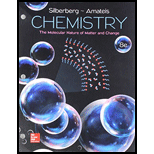
(a)
Interpretation:
The variables that determines whether an
Concept introduction:
Reaction: Substances which are mutually involved each other in a chemical process and changed into different substances.
Mechanism of a reaction: The representation of step by step process involved in the chemical process is said to be mechanism of a
Elementary step: The first step in a reaction mechanism is said to be elementary step.
Intermediate: Sometimes, in between the reaction some separable amount and useful amount of substances are formed during the reaction and which are said to be intermediates
(b)
Interpretation:
The reactions that requires a higher temperature has to be discussed.
Concept introduction:
Reaction: Substances which are mutually involved each other in a chemical process and changed into different substances.
Mechanism of a reaction: The representation of step by step process involved in the chemical process is said to be mechanism of a chemical reaction.
Elementary step: The first step in a reaction mechanism is said to be elementary step.
Intermediate: Sometimes, in between the reaction some separable amount and useful amount of substances are formed during the reaction and which are said to be intermediates
(c)
Interpretation:
All the trans-fats arise during hydrogenation of fats that contain some double bonds with a cis-orientation has to be interpreted.
Concept introduction:
Reaction: Substances which are mutually involved each other in a chemical process and changed into different substances.
Mechanism of a reaction: The representation of step by step process involved in the chemical process is said to be mechanism of a chemical reaction.
Elementary step: The first step in a reaction mechanism is said to be elementary step.
Intermediate: Sometimes, in between the reaction some separable amount and useful amount of substances are formed during the reaction and which are said to be intermediates
Want to see the full answer?
Check out a sample textbook solution
Chapter 16 Solutions
Loose Leaf for Chemistry: The Molecular Nature of Matter and Change
- Synthesize 2-Ethyl-3-methyloxirane from dimethyl(propyl)sulfonium iodide using the necessary organic or inorganic reagents. Draw the structures of the compounds.arrow_forwardSynthesize 2-Hydroxy-2-phenylacetonitrile from phenylmethanol using the necessary organic or inorganic reagents. Draw the structures of the compounds.arrow_forwardSynthesize N-Methylcyclohexylamine from cyclohexanol using the necessary organic or inorganic reagents. Draw the structures of the compounds.arrow_forward
- Synthesize N-Methylcyclohexylamine from cyclohexanol using the necessary organic or inorganic reagents. Draw the structures of the compounds.arrow_forwardIf possible, please provide the formula of the compound 3,3-dimethylbut-2-enal.arrow_forwardSynthesize 1,4-dibromobenzene from acetanilide (N-phenylacetamide) using the necessary organic or inorganic reagents. Draw the structures of the compounds.arrow_forward
- Indicate the products obtained by mixing (3-oxo-3-phenylpropyl)triphenylphosphonium bromide with sodium hydride.arrow_forwardWe mix N-ethyl-2-hexanamine with excess methyl iodide and followed by heating with aqueous Ag2O. Indicate the major products obtained.arrow_forwardIndicate the products obtained by mixing acetophenone with iodine and NaOH.arrow_forward
- Indicate the products obtained by mixing 2-Propanone and ethyllithium and performing a subsequent acid hydrolysis.arrow_forwardIndicate the products obtained if (E)-2-butenal and 3-oxo-butanenitrile are mixed with sodium ethoxide in ethanol.arrow_forwardQuestion 3 (4 points), Draw a full arrow-pushing mechanism for the following reaction Please draw all structures clearly. Note that this intramolecular cyclization is analogous to the mechanism for halohydrin formation. COH Br + HBr Brarrow_forward
 ChemistryChemistryISBN:9781305957404Author:Steven S. Zumdahl, Susan A. Zumdahl, Donald J. DeCostePublisher:Cengage Learning
ChemistryChemistryISBN:9781305957404Author:Steven S. Zumdahl, Susan A. Zumdahl, Donald J. DeCostePublisher:Cengage Learning ChemistryChemistryISBN:9781259911156Author:Raymond Chang Dr., Jason Overby ProfessorPublisher:McGraw-Hill Education
ChemistryChemistryISBN:9781259911156Author:Raymond Chang Dr., Jason Overby ProfessorPublisher:McGraw-Hill Education Principles of Instrumental AnalysisChemistryISBN:9781305577213Author:Douglas A. Skoog, F. James Holler, Stanley R. CrouchPublisher:Cengage Learning
Principles of Instrumental AnalysisChemistryISBN:9781305577213Author:Douglas A. Skoog, F. James Holler, Stanley R. CrouchPublisher:Cengage Learning Organic ChemistryChemistryISBN:9780078021558Author:Janice Gorzynski Smith Dr.Publisher:McGraw-Hill Education
Organic ChemistryChemistryISBN:9780078021558Author:Janice Gorzynski Smith Dr.Publisher:McGraw-Hill Education Chemistry: Principles and ReactionsChemistryISBN:9781305079373Author:William L. Masterton, Cecile N. HurleyPublisher:Cengage Learning
Chemistry: Principles and ReactionsChemistryISBN:9781305079373Author:William L. Masterton, Cecile N. HurleyPublisher:Cengage Learning Elementary Principles of Chemical Processes, Bind...ChemistryISBN:9781118431221Author:Richard M. Felder, Ronald W. Rousseau, Lisa G. BullardPublisher:WILEY
Elementary Principles of Chemical Processes, Bind...ChemistryISBN:9781118431221Author:Richard M. Felder, Ronald W. Rousseau, Lisa G. BullardPublisher:WILEY





